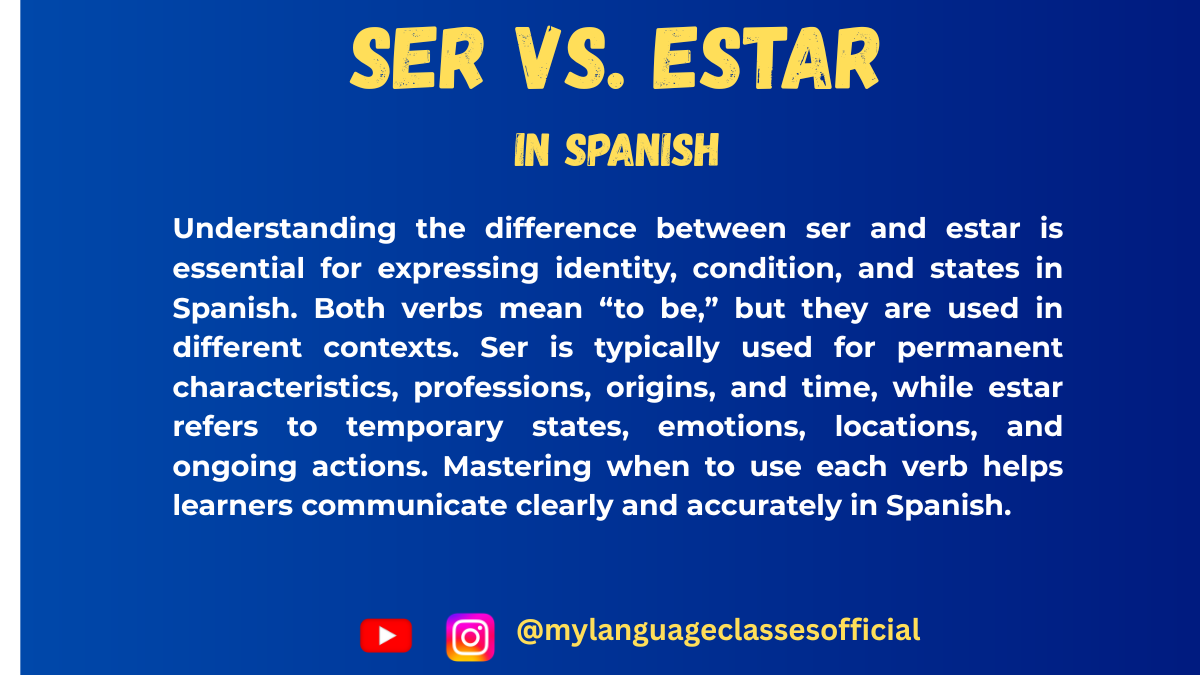Your cart is currently empty!
Tag: list of situations to use ser vs estar
-

Ser vs. Estar in Spanish
Understanding “Ser” vs. “Estar” in Spanish
One of the most challenging aspects of learning Spanish is distinguishing between ser and estar, two verbs that both mean “to be.” While their English translation is the same, their usage in Spanish depends on context, permanence, and perspective. In this blog post, we’ll delve into their meanings, conjugations, and common expressions used in daily life.
Ser vs. Estar: The Key Difference
- Ser is used for permanent or inherent characteristics, identity, and origin.
- Estar is used for temporary states, conditions, and locations.
When to Use “Ser”
- Identity and Characteristics
- Used for defining characteristics that don’t change.
- Examples:
- Soy alta. (I am tall.)
- Él es médico. (He is a doctor.)
- Origin and Nationality
- Express where someone or something is from.
- Examples:
- Somos de México. (We are from Mexico.)
- Esta fruta es de España. (This fruit is from Spain.)
- Time and Dates
- Used for telling time, days, and dates.
- Examples:
- ¿Qué hora es? Es la una. (What time is it? It’s one o’clock.)
- Hoy es lunes. (Today is Monday.)
- Possession
- Indicates ownership.
- Examples:
- Este libro es mío. (This book is mine.)
- Events
- Refers to the location of events.
- Example:
- La reunión es en la oficina. (The meeting is in the office.)
When to Use “Estar”
- Location
- Indicates where someone or something is located.
- Examples:
- Estoy en casa. (I am at home.)
- El libro está en la mesa. (The book is on the table.)
- Temporary States or Conditions
- Refers to emotions, health, and temporary states.
- Examples:
- Estoy feliz. (I am happy.)
- Ella está enferma. (She is sick.)
- Progressive Actions
- Used with the gerund to form the present continuous.
- Example:
- Estoy estudiando. (I am studying.)
- Temporary Qualities or Situations
- Highlights a changeable quality.
- Examples:
- La sopa está caliente. (The soup is hot.)
- El cielo está azul. (The sky is blue.)
Common Expressions with “Ser” and “Estar”
With Ser
- Ser bueno/malo: To be good/bad (characteristic)
- Ella es buena. (She is good/kind.)
- Ser un genio: To be a genius
- ¡Eres un genio! (You’re a genius!)
With Estar
- Estar bien/mal: To be well/unwell
- Estoy bien, gracias. (I am well, thank you.)
- Estar de acuerdo: To agree
- Estamos de acuerdo. (We agree.)
- Estar en casa: To be at home
- ¿Estás en casa? (Are you at home?)
Conjugation of Ser and Estar
Present Indicative
- Ser: soy, eres, es, somos, sois, son
- Estar: estoy, estás, está, estamos, estáis, están
Pretérito Perfecto (Present Perfect)
- Ser: he sido, has sido, ha sido, hemos sido, habéis sido, han sido
- Estar: he estado, has estado, ha estado, hemos estado, habéis estado, han estado
Pretérito Imperfecto
- Ser: era, eras, era, éramos, erais, eran
- Estar: estaba, estabas, estaba, estábamos, estabais, estaban
Imperative
- Ser: sé, sea, seamos, sed, sean
- Estar: está, esté, estemos, estad, estén
Present Subjunctive
- Ser: sea, seas, sea, seamos, seáis, sean
- Estar: esté, estés, esté, estemos, estéis, estén
Tips for Mastering Ser and Estar
- Context is King: Always ask whether the trait is permanent or temporary.
- Adjective Matters: Some adjectives change meaning based on the verb. For example:
- Ser listo: To be clever
- Estar listo: To be ready
- Articles and Agreement: Pay attention to gender and plurality.
- La niña es alta. (The girl is tall.)
- Los niños están felices. (The boys are happy.)
Mastering ser and estar requires practice and attention to detail. With these explanations, examples, and expressions, you’ll build confidence in distinguishing these essential verbs. Keep practicing, and soon, using ser and estar will feel as natural as their meanings!
Let me know if you’d like more tips or exercises! 😊
If you found this guide helpful, I’d love to hear from you! Share your thoughts in the comments below or connect with me on social media. For more tips, resources, and inspiration, visit my blog at mylanguageclasses.in. Follow on Instagram and subscribe on YouTube
📚 Continue Learning Spanish
Share this:
- Click to share on Facebook (Opens in new window) Facebook
- Click to share on X (Opens in new window) X
- More
- Click to email a link to a friend (Opens in new window) Email
- Click to share on LinkedIn (Opens in new window) LinkedIn
- Click to share on Reddit (Opens in new window) Reddit
- Click to share on Tumblr (Opens in new window) Tumblr
- Click to share on Pinterest (Opens in new window) Pinterest
- Click to share on Pocket (Opens in new window) Pocket
- Click to share on Telegram (Opens in new window) Telegram
- Click to share on Threads (Opens in new window) Threads
- Click to share on WhatsApp (Opens in new window) WhatsApp
- Click to share on Mastodon (Opens in new window) Mastodon
- Click to share on Nextdoor (Opens in new window) Nextdoor
- Click to share on Bluesky (Opens in new window) Bluesky
